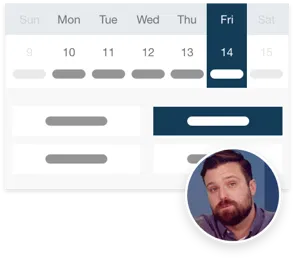Property leasing & management is a balance between customer service, legal compliance, and operational efficiency. As a residential property manager, your role bridges the gap between property owners and tenants, and how well you manage this connection can shape the experience of everyone involved.
Start your free trial today!
Try Buildium for free for 14 days. No credit card needed.
Start Your TrialIn this post, we’ll walk you through the key areas of property leasing & management. Whether you’re new to the field or an experienced pro, you’ll walk away with practical strategies to improve your day-to-day operations, build better tenant relationships, and maintain compliance with important laws. Think of this as your go-to guide for making your property leasing & management process more efficient and tenant-friendly.
The Essentials of Property Leasing & Management
Property leasing sets the tone for your relationship with tenants. When you get the leasing process right, you set the stage for clear expectations, smooth interactions, and a solid foundation for the tenant-owner relationship. Let’s dive into the key elements of leasing, including crafting a lease agreement, screening tenants, and using the right technology to save you time.
Craft a Solid Lease Agreement
Your lease agreement serves as the blueprint for the tenant’s entire stay. This is the document that outlines both tenant and property owner expectations. A few tips for writing a lease agreement that works for both parties:
- Keep It Simple: Avoid using complicated legal jargon. Use straightforward language so tenants can easily understand their responsibilities and rights. You don’t want them second-guessing any clauses.
- Be Detailed: Include all the necessary information, such as the rent amount, due dates, security deposit, and any property-specific rules. For example, you might want to address parking, noise, or pet policies directly in the lease.
- Be Clear About Fees: If there are penalties for late payments or bounced checks, make sure you outline them clearly. Tenants should know what’s expected upfront.
- Tailor It to Your Property: Different properties may need special clauses. For instance, a building with shared laundry facilities should include rules about their usage, or a building in a quiet neighborhood should emphasize noise restrictions.
Read more: For a more detailed explanation of lease agreements check out our related post here.
Tenant Screening Made Simple
Tenant screening is your first line of defense against potential problems down the road. It’s all about finding responsible renters who will treat the property well and pay rent on time. Here’s how to make the process both fair and thorough:
- Do Background Checks: A background check helps uncover any criminal history or past evictions that could indicate a problematic tenant. It’s not about being judgmental, but rather about protecting your property and other residents.
- Credit History: Look at potential tenants’ credit history to gauge their financial responsibility. You’re not looking for perfect credit scores, but you want to make sure they can afford rent without straining their budget.
- Verify Income: Make sure tenants can cover the rent. As a rule of thumb, their monthly income should be at least three times the rent amount. This ensures they’re financially capable of handling the rent and living expenses.
Setting Rent that Works for You and Tenants
Setting the right rental price is a delicate balancing act that requires you to consider the interests of both your clients and your potential tenants. Here’s some of the basics to help you set your rent:
- Research the Market: Check what other properties in your area are charging. Sites such as Zillow, Rent.com, and Apartments.com offer a good sense of current rental prices in your neighborhood.
- Factor in the Property’s Condition: Your rental price should reflect the property’s age, condition, and amenities. A newly renovated apartment with upgraded appliances can often command higher rent than an outdated one.
- Adjust for Seasonality: Rent can fluctuate based on the time of year. Summer tends to be a high-demand period, so you might be able to raise rent slightly during peak rental season.
Effective Property Leasing & Management Practices
After the lease is signed, it’s time to dive into property management. The day-to-day tasks of managing your property will involve everything from handling maintenance requests to keeping tenants informed. Here are some practical steps for managing properties with ease and efficiency.
Stay on Top of Maintenance Requests
Timely maintenance is key to tenant satisfaction and property longevity. Here’s how to manage repairs and maintenance requests effectively:
- Set Up an Online Portal: Use an online maintenance portal where tenants can submit requests. This gives tenants an easy way to communicate with you while also keeping a digital record of everything.
- Respond Promptly: Acknowledge requests quickly, even if you’re not yet able to fix the issue. A simple response such as “We received your request and are working on it” helps keep tenants in the loop and reduces their anxiety.
- Proactive Maintenance: Regular property inspections help spot small issues before they become big problems. Schedule seasonal checkups to inspect HVAC systems, plumbing, and other vital parts of the property.
Communicate with Tenants Effectively
Good communication can prevent misunderstandings and promote positive tenant relationships. Here’s how to stay connected with your tenants:
- Send Regular Updates: Whether it’s about a change in building rules or an upcoming inspection, keeping tenants informed through email or community bulletins can reduce frustration and confusion.
- Be Available: Make sure tenants know how to reach you, whether by phone, email, or a messaging platform. Quick responses can resolve issues before they escalate into bigger problems.
- Tackle Issues Proactively: If a tenant has a complaint or a concern, address it right away. Handling issues with empathy and professionalism can turn an unhappy tenant into a loyal one.
Use Technology to Simplify Your Property Leasing & Management Workflow
Managing multiple properties can get overwhelming, but technology can help you stay organized. Use software tools to streamline day-to-day operations:
- Property Management Software: Platforms such as Buildium or Propertyware offer everything from rent collection to maintenance tracking. Using these tools will save you time and reduce errors.
- Online Rent Payment: Offer tenants the convenience of paying rent online. This eliminates the need for checks and reduces the chances of late payments.
- Inspection Apps: Tools such as HappyCo help you conduct property inspections more efficiently, saving you time while keeping your process thorough.
Legal Considerations and Compliance
Navigating legal requirements is a major part of property management. Compliance with laws protects your business and your tenants. Let’s go over the most important legal aspects of property management.
Disclaimer: These details are meant for general information to consider and do not constitute legal advice. Speak to a legal professional for specific details before making any decisions regarding legal compliance.
Understanding Fair Housing Laws
Fair housing laws exist to protect tenants from discrimination. Make sure your leasing practices align with federal, state, and local regulations, which prohibit discrimination based on race, religion, gender, disability, and other protected classes. Following these laws helps you build a fair and ethical rental environment.
Tenant Rights
Tenants are entitled to certain rights, including the right to a habitable living space, privacy, and protection from retaliation. Make sure your practices respect tenant rights, and stay current on any changes in local laws to avoid accidental violations.
It’s always a good idea to talk with a legal expert to get the most accurate advice on your particular situation and the laws in your area.
Tenant Relations and Retention Strategies
Building positive relationships with tenants is the secret to long-term success in property management. Tenants who feel valued are more likely to renew their leases and take care of the property. Here’s how to foster a positive environment:
Build Trust and Respect
Treat your tenants with respect from day one. A friendly greeting, clear communication, and prompt responses to their concerns will set a positive tone for the relationship.
Retain Tenants with Incentives
Tenant turnover is costly, which makes retention important. One strategy is to offer incentives to tenants who renew their leases, such as a small rent discount or a gift card. These little gestures show tenants that you value them and encourage them to stay.
Pro tip: Consider introducing services such as Gravy to incentive tenant loyalty and on time payments.
Create a Sense of Community
Host events or activities to create a sense of belonging within your building or complex. It could be a seasonal BBQ, a spring cleaning day, or a holiday gathering. When tenants feel connected to their neighbors, they’re more likely to stay.
Tools to Help with Property Leasing & Management
By following these practices—from creating clear lease agreements to fostering good tenant relationships—you can reduce stress, increase tenant satisfaction, and enhance your bottom line. Stay on top of industry changes, keep your knowledge fresh, and always strive to improve your practices.
Sometimes, that involves jumping in and testing software for yourself, to see if it’s worth the investment. Buildium offers a free 14-day trial and a guided demo to help you gauge if the platform can benefit your leasing operations.
As you apply tech like Buildium and the strategies above, you’ll not only optimize your workflow but also build a reputation for being a responsive and responsible property manager.
Read more on Leasing
